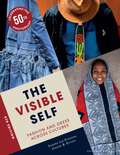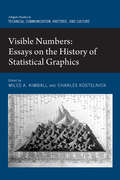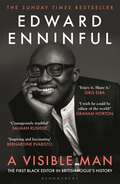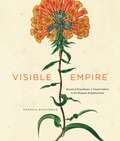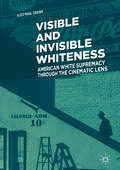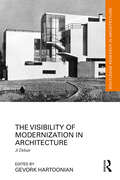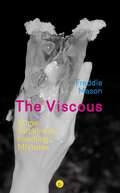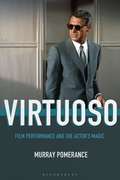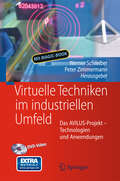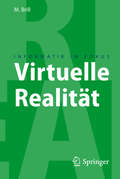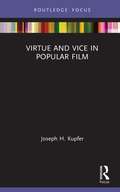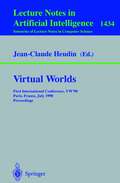- Table View
- List View
Visible Signs: An Introduction to Semiotics in the Visual Arts (Required Reading Range)
by David CrowBasic semiotic theories are taught in most art schools as part of a contextual studies program, but many students find it difficult to understand how these ideas might impact on their own practice. Visible Signs tackles this problem by introducing key theories and concepts, such as signs and signifiers, and language and speech, within the framework of visual communication. Each chapter provides an overview of a particular facet of semiotic theory, with inspiring examples from graphic design, typography, illustration, advertising and art to illustrate the ideas discussed in the text. Creative exercises at the end of the book will help exemplify these ideas through practical application. The third edition of Visible Signs features new material from international designers and new creative exercises to accompany each chapter. This new edition also features a new design and layout.
Visible Signs: An Introduction to Semiotics in the Visual Arts (Required Reading Range Ser.)
by David CrowBasic semiotic theories are taught in most art schools as part of a contextual studies program, but many students find it difficult to understand how these ideas might impact on their own practice. Visible Signs tackles this problem by introducing key theories and concepts, such as signs and signifiers, and language and speech, within the framework of visual communication. Each chapter provides an overview of a particular facet of semiotic theory, with inspiring examples from graphic design, typography, illustration, advertising and art to illustrate the ideas discussed in the text. Creative exercises at the end of the book will help exemplify these ideas through practical application. The fourth edition of Visible Signs includes new imagery and updated exercises, as well as coverage of propaganda, diversity in 'neutral' communication (like emojis), and issues related to social media representation.
Visible Signs: An Introduction to Semiotics in the Visual Arts
by David CrowBasic semiotic theories are taught in most art schools as part of a contextual studies program, but many students find it difficult to understand how these ideas might impact on their own practice. Visible Signs tackles this problem by introducing key theories and concepts, such as signs and signifiers, and language and speech, within the framework of visual communication. Each chapter provides an overview of a particular facet of semiotic theory, with inspiring examples from graphic design, typography, illustration, advertising and art to illustrate the ideas discussed in the text. Creative exercises at the end of the book will help exemplify these ideas through practical application. The fourth edition of Visible Signs includes new imagery and updated exercises, as well as coverage of propaganda, diversity in 'neutral' communication (like emojis), and issues related to social media representation.
Visible Signs: An Introduction to Semiotics in the Visual Arts (Required Reading Range Ser.)
by Mr David CrowBasic semiotic theories are taught in most art schools as part of a contextual studies program, but many students find it difficult to understand how these ideas might impact on their own practice. Visible Signs tackles this problem by introducing key theories and concepts, such as signs and signifiers, and language and speech, within the framework of visual communication. Each chapter provides an overview of a particular facet of semiotic theory, with inspiring examples from graphic design, typography, illustration, advertising and art to illustrate the ideas discussed in the text. Creative exercises at the end of the book will help exemplify these ideas through practical application. The third edition of Visible Signs features new material from international designers and new creative exercises to accompany each chapter. This new edition also features a new design and layout.
The Visible Self: Fashion and Dress Across Cultures - with STUDIO
by Joanne B. Eicher Sandra Lee EvensonAll over the world, people get dressed, mostly for the same reasons. Why, then, do we look so different from each other? The answers lie in the constellations of factors that contribute to the human condition, from climate to conformity, gender expression to race and ethnicity.Beginning with the body as the organizing principle around which to study dress, this 50th anniversary edition of The Visible Self makes sense of humans as biological, social, and aesthetic creatures based on cross-disciplinary concepts and examples. It explores the daily act of dress in cultures around the world, using the word “dress” to describe the wide variety of behaviors connected to the act of adorning our bodies-or not-through the use of clothing, modifications, and/or supplements. Political economies are addressed holistically to understand the global world through contemporary topics such as racism and how dress can be used to sustain or rebel against dominant structures. With current examples and relevant readings in every chapter, the authors convey how dress can achieve standards of appearance and social ideals, relate to individuality and conformity in fashion, and communicate identity and character in the arts. Exploring the global mash-up of fashion, dress, culture, production, and sustainability-including life in a post-pandemic world-The Visible Self offers a powerful understanding of the way we look and how we look at others.New to this Edition: - Focus on the body as the organizing principle in the study of dress including additional insight on fashion and using this concept to define the target customer - Investigation of current issues such as race and the post-pandemic world - Updated readings, at the end of each chapter, with discussion questions that directly connect chapter concepts to reading content - Activities that apply chapter concepts to design, product development, merchandising, and everyday life STUDIO Features Include: - Links to third party video clips to help visualize how dress is used to identify the self - Self-assessment quizzes to test yourself on what you have just read - Flashcards of key terms and concepts covered in the book Instructor Resources - Instructor's Guide to help incorporate the text into your classroom - Test Bank to highly key concepts and test student comprehension on those concepts - PowerPoint Slides for every chapter
Visible Numbers: Essays on the History of Statistical Graphics
by Charles KostelnickBringing together scholars from around the world, this collection examines many of the historical developments in making data visible through charts, graphs, thematic maps, and now interactive displays. Today, we are used to seeing data portrayed in a dizzying array of graphic forms. Virtually any quantified knowledge, from social and physical science to engineering and medicine, as well as business, government, or personal activity, has been visualized. Yet the methods of making data visible are relatively new innovations, most stemming from eighteenth- and nineteenth-century innovations that arose as a logical response to a growing desire to quantify everything-from science, economics, and industry to population, health, and crime. Innovators such as Playfair, Alexander von Humboldt, Heinrich Berghaus, John Snow, Florence Nightingale, Francis Galton, and Charles Minard began to develop graphical methods to make data and their relations more visible. In the twentieth century, data design became both increasingly specialized within new and existing disciplines-science, engineering, social science, and medicine-and at the same time became further democratized, with new forms that make statistical, business, and government data more accessible to the public. At the close of the twentieth century and the beginning of the twenty-first, an explosion in interactive digital data design has exponentially increased our access to data. The contributors analyze this fascinating history through a variety of critical approaches, including visual rhetoric, visual culture, genre theory, and fully contextualized historical scholarship.
Visible Numbers: Essays on the History of Statistical Graphics (Routledge Studies In Technical Communication, Rhetoric, And Culture Ser.)
by Charles Kostelnick Miles A. KimballBringing together scholars from around the world, this collection examines many of the historical developments in making data visible through charts, graphs, thematic maps, and now interactive displays. Today, we are used to seeing data portrayed in a dizzying array of graphic forms. Virtually any quantified knowledge, from social and physical science to engineering and medicine, as well as business, government, or personal activity, has been visualized. Yet the methods of making data visible are relatively new innovations, most stemming from eighteenth- and nineteenth-century innovations that arose as a logical response to a growing desire to quantify everything-from science, economics, and industry to population, health, and crime. Innovators such as Playfair, Alexander von Humboldt, Heinrich Berghaus, John Snow, Florence Nightingale, Francis Galton, and Charles Minard began to develop graphical methods to make data and their relations more visible. In the twentieth century, data design became both increasingly specialized within new and existing disciplines-science, engineering, social science, and medicine-and at the same time became further democratized, with new forms that make statistical, business, and government data more accessible to the public. At the close of the twentieth century and the beginning of the twenty-first, an explosion in interactive digital data design has exponentially increased our access to data. The contributors analyze this fascinating history through a variety of critical approaches, including visual rhetoric, visual culture, genre theory, and fully contextualized historical scholarship.
A Visible Man: The inspiring memoir from the first Black editor-in-chief of British Vogue
by Edward Enninful'Enjoy it. Share it.' IDRIS ELBA'This book is a revelation' DONATELLA VERSACE 'Edward's journey is a lesson for the culture and future generations to come' NAOMI CAMPBELL'Inspiring and fascinating' BERNARDINE EVARISTO'Courageously truthful' SALMAN RUSHDIEEdward Enninful has lived an extraordinary life.Here, for the first time, he shares the remarkable, inspiring story of his journey from a childhood bedroom in Ghana overlooking firing squads, to 1990s London – becoming the youngest-ever fashion director of i-D magazine at just eighteen years old. Now the first Black editor-in-chief of British Vogue, he has created game-changing images of everyone from Beyoncé to Meghan Markle, Kate Moss to Oprah Winfrey, Adele to Rihanna, and many more stars he now counts as friends.A Visible Man is the story of a husband, son, brother, friend – and icon. Taking us from the neon thrills of Soho clubs to nights spent on friends' sofas, this is the story of Edward's phenomenal grit and determination: of failures, loss, coming out, joy, hedonism, fame, love, heartbreak, sacrifice, ill health and era-defining achievements. It's the story of one man's revolutionary mission to change how we see the world, showing how unwavering passion and perseverance can allow anyone to make their mark – just like he did.
A Visible Man: The inspiring memoir from the first Black editor-in-chief of British Vogue
by Edward Enninful'Enjoy it. Share it.' IDRIS ELBA'This book is a revelation' DONATELLA VERSACE 'Edward's journey is a lesson for the culture and future generations to come' NAOMI CAMPBELL'Inspiring and fascinating' BERNARDINE EVARISTO'Courageously truthful' SALMAN RUSHDIEEdward Enninful has lived an extraordinary life.Here, for the first time, he shares the remarkable, inspiring story of his journey from a childhood bedroom in Ghana overlooking firing squads, to 1990s London – becoming the youngest-ever fashion director of i-D magazine at just eighteen years old. Now the first Black editor-in-chief of British Vogue, he has created game-changing images of everyone from Beyoncé to Meghan Markle, Kate Moss to Oprah Winfrey, Adele to Rihanna, and many more stars he now counts as friends.A Visible Man is the story of a husband, son, brother, friend – and icon. Taking us from the neon thrills of Soho clubs to nights spent on friends' sofas, this is the story of Edward's phenomenal grit and determination: of failures, loss, coming out, joy, hedonism, fame, love, heartbreak, sacrifice, ill health and era-defining achievements. It's the story of one man's revolutionary mission to change how we see the world, showing how unwavering passion and perseverance can allow anyone to make their mark – just like he did.
Visible Empire: Botanical Expeditions and Visual Culture in the Hispanic Enlightenment
by Daniela BleichmarBetween 1777 and 1816, botanical expeditions crisscrossed the vast Spanish empire in an ambitious project to survey the flora of much of the Americas, the Caribbean, and the Philippines. While these voyages produced written texts and compiled collections of specimens, they dedicated an overwhelming proportion of their resources and energy to the creation of visual materials. European and American naturalists and artists collaborated to manufacture a staggering total of more than 12,000 botanical illustrations. Yet these images have remained largely overlooked—until now. In this lavishly illustrated volume, Daniela Bleichmar gives this archive its due, finding in these botanical images a window into the worlds of Enlightenment science, visual culture, and empire. Through innovative interdisciplinary scholarship that bridges the histories of science, visual culture, and the Hispanic world, Bleichmar uses these images to trace two related histories: the little-known history of scientific expeditions in the Hispanic Enlightenment and the history of visual evidence in both science and administration in the early modern Spanish empire. As Bleichmar shows, in the Spanish empire visual epistemology operated not only in scientific contexts but also as part of an imperial apparatus that had a long-established tradition of deploying visual evidence for administrative purposes.
Visible Empire: Botanical Expeditions and Visual Culture in the Hispanic Enlightenment
by Daniela BleichmarBetween 1777 and 1816, botanical expeditions crisscrossed the vast Spanish empire in an ambitious project to survey the flora of much of the Americas, the Caribbean, and the Philippines. While these voyages produced written texts and compiled collections of specimens, they dedicated an overwhelming proportion of their resources and energy to the creation of visual materials. European and American naturalists and artists collaborated to manufacture a staggering total of more than 12,000 botanical illustrations. Yet these images have remained largely overlooked—until now. In this lavishly illustrated volume, Daniela Bleichmar gives this archive its due, finding in these botanical images a window into the worlds of Enlightenment science, visual culture, and empire. Through innovative interdisciplinary scholarship that bridges the histories of science, visual culture, and the Hispanic world, Bleichmar uses these images to trace two related histories: the little-known history of scientific expeditions in the Hispanic Enlightenment and the history of visual evidence in both science and administration in the early modern Spanish empire. As Bleichmar shows, in the Spanish empire visual epistemology operated not only in scientific contexts but also as part of an imperial apparatus that had a long-established tradition of deploying visual evidence for administrative purposes.
Visible Empire: Botanical Expeditions and Visual Culture in the Hispanic Enlightenment
by Daniela BleichmarBetween 1777 and 1816, botanical expeditions crisscrossed the vast Spanish empire in an ambitious project to survey the flora of much of the Americas, the Caribbean, and the Philippines. While these voyages produced written texts and compiled collections of specimens, they dedicated an overwhelming proportion of their resources and energy to the creation of visual materials. European and American naturalists and artists collaborated to manufacture a staggering total of more than 12,000 botanical illustrations. Yet these images have remained largely overlooked—until now. In this lavishly illustrated volume, Daniela Bleichmar gives this archive its due, finding in these botanical images a window into the worlds of Enlightenment science, visual culture, and empire. Through innovative interdisciplinary scholarship that bridges the histories of science, visual culture, and the Hispanic world, Bleichmar uses these images to trace two related histories: the little-known history of scientific expeditions in the Hispanic Enlightenment and the history of visual evidence in both science and administration in the early modern Spanish empire. As Bleichmar shows, in the Spanish empire visual epistemology operated not only in scientific contexts but also as part of an imperial apparatus that had a long-established tradition of deploying visual evidence for administrative purposes.
Visible Empire: Botanical Expeditions and Visual Culture in the Hispanic Enlightenment
by Daniela BleichmarBetween 1777 and 1816, botanical expeditions crisscrossed the vast Spanish empire in an ambitious project to survey the flora of much of the Americas, the Caribbean, and the Philippines. While these voyages produced written texts and compiled collections of specimens, they dedicated an overwhelming proportion of their resources and energy to the creation of visual materials. European and American naturalists and artists collaborated to manufacture a staggering total of more than 12,000 botanical illustrations. Yet these images have remained largely overlooked—until now. In this lavishly illustrated volume, Daniela Bleichmar gives this archive its due, finding in these botanical images a window into the worlds of Enlightenment science, visual culture, and empire. Through innovative interdisciplinary scholarship that bridges the histories of science, visual culture, and the Hispanic world, Bleichmar uses these images to trace two related histories: the little-known history of scientific expeditions in the Hispanic Enlightenment and the history of visual evidence in both science and administration in the early modern Spanish empire. As Bleichmar shows, in the Spanish empire visual epistemology operated not only in scientific contexts but also as part of an imperial apparatus that had a long-established tradition of deploying visual evidence for administrative purposes.
Visible and Invisible Whiteness: American White Supremacy through the Cinematic Lens
by Alice Mikal CravenVisible and Invisible Whiteness examines the complicity between Classical Hollywood narratives or genres and representations of white supremacy in the cinema. Close readings of D.W. Griffith’s The Birth of a Nation by James Agee and James Baldwin explore these authors’ perspectives on the American mythologies which ground Griffith’s film. The intersectionality of Bordwell’s theories on Classical Hollywood Narrative versus Art Cinema and Richard Dyer’s seminal work on whiteness forms the theoretical base for the book. Featured films are those which have been undervalued or banned due to their hybrid natures with respect to Hollywood and Art Cinema techniques, such as Samuel Fuller’s White Dog and Jean Renoir’s The Southerner. The book offers comparative analyses of American studio-based directors as well as European and European émigrés directors. It appeals to scholars of Film Theory, African American and Whiteness Studies. It provides insight for readers concerned about the re-emergence of white supremacist tensions in contemporary America.
Visible and Invisible Whiteness: American White Supremacy through the Cinematic Lens
by Alice Mikal CravenVisible and Invisible Whiteness examines the complicity between Classical Hollywood narratives or genres and representations of white supremacy in the cinema. Close readings of D.W. Griffith’s The Birth of a Nation by James Agee and James Baldwin explore these authors’ perspectives on the American mythologies which ground Griffith’s film. The intersectionality of Bordwell’s theories on Classical Hollywood Narrative versus Art Cinema and Richard Dyer’s seminal work on whiteness forms the theoretical base for the book. Featured films are those which have been undervalued or banned due to their hybrid natures with respect to Hollywood and Art Cinema techniques, such as Samuel Fuller’s White Dog and Jean Renoir’s The Southerner. The book offers comparative analyses of American studio-based directors as well as European and European émigrés directors. It appeals to scholars of Film Theory, African American and Whiteness Studies. It provides insight for readers concerned about the re-emergence of white supremacist tensions in contemporary America.
The Visibility of Modernization in Architecture: A Debate (Routledge Research in Architecture)
by Gevork HartoonianThis edited collection explores the visibility of modernization in architecture produced in different capitalist regions across the world and provides readers with a historico-theoretical and historico-geographical discussion. Focusing on a particular building type, an influential architect’s work, as well as relevant texts and documents, each chapter addresses the many facets of "delay" which are central to the problematization of capitalism’s progressive dissemination of technological and aesthetic regimes of modernism. This collection underlines the centrality of temporality for a critical understanding of colonialism, modernism, and capitalism. The book is primarily concerned with the historical timeline, the tangential point when a nation enters modernization processes. In exploring modernism in diverse regions such as East Asia, Pacific, Eastern Europe, and Iran, each chapter addresses the historiographic and architectonic unfolding of modernization beyond the western hemisphere. The exploration of these diverse case-studies will be of interest to students of architecture and researchers working on the collision of temporalities and the subject's critical importance for different country’s built-environments.
The Visibility of Modernization in Architecture: A Debate (Routledge Research in Architecture)
by Gevork HartoonianThis edited collection explores the visibility of modernization in architecture produced in different capitalist regions across the world and provides readers with a historico-theoretical and historico-geographical discussion. Focusing on a particular building type, an influential architect’s work, as well as relevant texts and documents, each chapter addresses the many facets of "delay" which are central to the problematization of capitalism’s progressive dissemination of technological and aesthetic regimes of modernism. This collection underlines the centrality of temporality for a critical understanding of colonialism, modernism, and capitalism. The book is primarily concerned with the historical timeline, the tangential point when a nation enters modernization processes. In exploring modernism in diverse regions such as East Asia, Pacific, Eastern Europe, and Iran, each chapter addresses the historiographic and architectonic unfolding of modernization beyond the western hemisphere. The exploration of these diverse case-studies will be of interest to students of architecture and researchers working on the collision of temporalities and the subject's critical importance for different country’s built-environments.
The Viscous: Slime, Stickiness, Fondling, Mixtures
by Freddie MasonSlime, goo, gunge, gloop, gels, sols, globules, jellies, emulsions, greases, soaps, syrups, glues, lubricants, liquid crystals, moulds, plasmas, and protoplasms – the viscous is not one thing, but rather a quality of resistance and flow, of stickiness and slipperiness. It is a state of matter that oozes into the gaps of our everyday existence, across age groups, between cultures and disciplines.Since the large-scale extraction of petroleum in the 19th century, the viscous has witnessed a proliferation in the variety of its forms. Mechanized industry required lubricants and oil distillation produced waste products that were refined to form Vaseline. From this age, new viscous forms and technologies emerged: products from plastic (and plastic explosives) to cosmetics, glycerine, asphalt, sexual lubrication, hydro- and aero-gels, and even anti-climb paint.Based on unique and wide-ranging research, The Viscous is the first major investigation of encounters with and possibilities of the viscous over the course of the last century, not simply as a material state, but also as an imaginative event. We enter into a story of matter at its most wayward, deviant, hesitant, and resistant.From asphalt lakes to industrial molasses tanks, from liquid crystals squirming in our screens to milk fetishes, The Viscous discloses gooeyness as a peculiarly modern phase of matter. "Everything oozes," as Beckett’s Estragon famously proclaims in Waiting for Godot. Viscous dynamics are exposed as not only hugely various in a post-industrial age, but particularly useful ways of thinking, feeling, writing, and making in a time of ecological anxiety.
Virtuoso: Film Performance and the Actor's Magic
by Murray PomeranceElizabeth Taylor's electrifying performance in Who's Afraid of Virginia Woolf? The milkshake scene in There Will be Blood. Leonardo DiCaprio's turn as Arnie in What's Eating Gilbert Grape? What makes these performances so special? Eloquently written and engagingly laid out, Murray Pomerance answers the tough question as to what makes an exceptional, or virtuosic performance. Pomerance intensively explores virtuosic performance in film, ranging from classical works through to contemporary production, and gives serious consideration to structural problems of dramatization and production, actorial methods and tricks, and contingencies that befall performers giving stand-out moments.Looking at more than 40 aspects of the virtuosic act, and using an approach based in careful meditation and discursion, Virtuoso moves through such themes as showing off, effacement, self-consciousness, performative collapse, spontaneity, acting as dream, acting and femininity, virtuosity and torture, secrecy, improvisation, virtuosic silence, and others; giving special attention to the labors of such figures as Fred Astaire, Johnny Depp, Marlene Dietrich, Basil Rathbone, Christopher Plummer, Leonardo DiCaprio, Alice Brady, Ethel Waters, James Mason, and dozens more. Numerous scenic virtuosities are examined in depth, from films as far-ranging as Singin' in the Rain and The Bridge on the River Kwai, and My Man Godfrey. As the first book about virtuosity in film performance, Virtuoso offers exciting new angles from which to view film both classical and contemporary.
Virtuoso: Film Performance and the Actor's Magic
by Murray PomeranceElizabeth Taylor's electrifying performance in Who's Afraid of Virginia Woolf? The milkshake scene in There Will be Blood. Leonardo DiCaprio's turn as Arnie in What's Eating Gilbert Grape? What makes these performances so special? Eloquently written and engagingly laid out, Murray Pomerance answers the tough question as to what makes an exceptional, or virtuosic performance. Pomerance intensively explores virtuosic performance in film, ranging from classical works through to contemporary production, and gives serious consideration to structural problems of dramatization and production, actorial methods and tricks, and contingencies that befall performers giving stand-out moments.Looking at more than 40 aspects of the virtuosic act, and using an approach based in careful meditation and discursion, Virtuoso moves through such themes as showing off, effacement, self-consciousness, performative collapse, spontaneity, acting as dream, acting and femininity, virtuosity and torture, secrecy, improvisation, virtuosic silence, and others; giving special attention to the labors of such figures as Fred Astaire, Johnny Depp, Marlene Dietrich, Basil Rathbone, Christopher Plummer, Leonardo DiCaprio, Alice Brady, Ethel Waters, James Mason, and dozens more. Numerous scenic virtuosities are examined in depth, from films as far-ranging as Singin' in the Rain and The Bridge on the River Kwai, and My Man Godfrey. As the first book about virtuosity in film performance, Virtuoso offers exciting new angles from which to view film both classical and contemporary.
Virtuelle Techniken im industriellen Umfeld: Das AVILUS-Projekt - Technologien und Anwendungen
by Werner Schreiber Peter ZimmermannIn dem Buch betrachten Experten den Einsatz virtueller Technologien über den gesamten Lebenszyklus eines Produkts hinweg – von der Entstehung bis zum End of Produktion (EOP). Dargestellt werden Konzepte zur Informationsbereitstellung im Product Life Cycle Management, Simulation und Rendering, Lokalisation und Tracking sowie weitere Fragen zur virtuellen und erweiterten Realität. Die Ergebnisse des AVILUS-Projekts zeigen, dass diese Technologien in kleinen und mittleren Unternehmen zur Steigerung von Wirtschaftlichkeit und Qualität beitragen können.
Virtuelle Realität (Informatik im Fokus)
by Manfred BrillVirtuelle Realität oder Virtual Reality (VR) hat in den letzten Jahren eine stürmische Entwicklung genommen. Dieses Buch führt in Theorie und Praxis der virtuellen Realität ein und liefert einen Überblick über Software-Architekturen. Der Schwerpunkt liegt bei Anwendungen der VR, beispielhafte Anwendungen werden mit VR Juggler betrachtet und implementiert. Für das erfolgreiche Bearbeiten der Aufgaben sind Erfahrungen im Programmieren mit C++ und OpenGL erforderlich, Kenntnisse in Computergrafik und Grafikprogrammierung werden vorausgesetzt.
Virtue and Vice in Popular Film (Routledge Focus on Film Studies)
by Joseph H. KupferThis book addresses a prominent group of virtues and vices as portrayed in popular films to further our understanding of these moral character traits. The discussions emphasize the interplay between the philosophical conception of the virtues and vices and the cinematic representations of character. Joseph H. Kupfer explores how fictional characters possessing certain moral strengths and weaknesses concretize our abstract understanding of them. Because the actions that flow from these traits occur in cinematic contexts mirroring real world conditions, the narrative portrayals of these moral characteristics can further our appreciation of their import. Humility, integrity, and perseverance, for example, are depicted in Chariots of Fire, The Fabulous Baker Boys, and Billy Elliot, while the vices of envy, arrogance and vanity are captured in Amadeus, Whiplash, and Young Adult. This interdisciplinary work in philosophy and film criticism will be of great interest to scholars and students of film studies, philosophy of film, ethics, aesthetics, and popular culture.
Virtue and Vice in Popular Film (Routledge Focus on Film Studies)
by Joseph H. KupferThis book addresses a prominent group of virtues and vices as portrayed in popular films to further our understanding of these moral character traits. The discussions emphasize the interplay between the philosophical conception of the virtues and vices and the cinematic representations of character. Joseph H. Kupfer explores how fictional characters possessing certain moral strengths and weaknesses concretize our abstract understanding of them. Because the actions that flow from these traits occur in cinematic contexts mirroring real world conditions, the narrative portrayals of these moral characteristics can further our appreciation of their import. Humility, integrity, and perseverance, for example, are depicted in Chariots of Fire, The Fabulous Baker Boys, and Billy Elliot, while the vices of envy, arrogance and vanity are captured in Amadeus, Whiplash, and Young Adult. This interdisciplinary work in philosophy and film criticism will be of great interest to scholars and students of film studies, philosophy of film, ethics, aesthetics, and popular culture.
Virtual Worlds: First International Conference, VW’98 Paris, France, July 1–3, 1998 Proceedings (Lecture Notes in Computer Science #1434)
by Jean-Claude Heudin1 Introduction Imagine a virtual world with digital creatures that looks like real life, sounds like real life, and even feels like real life. Imagine a virtual world not only with nice three dimensional graphics and animations, but also with realistic physical laws and forces. This virtual world could be familiar, reproducing some parts of our reality, or unfa miliar, with strange “physical” laws and artificial life forms. As a researcher interested in the sciences of complexity, the idea of a conference about virtual worlds emerged from frustration. In the last few years, there has been an increasing interest in the design of artificial environments using image synthesis and virtual reality. The emergence of industry standards such as VRML [1] is an illustra tion of this growing interest. At the same time, the field of Artificial Life has ad dressed and modeled complex phenomena such as self organization, reproduction, development, and evolution of artificial life like systems [2]. One of the most popular works in this field has been Tierra designed by Tom Ray: an environment producing synthetic organisms based on a computer metaphor of organic life in which CPU time is the “energy” resource and memory is the “material” resource [3]. Memory is or ganized into informational patterns that exploit CPU time for self replication. Muta tion generates new forms, and evolution proceeds by natural selection as different creatures compete for CPU time and memory space.



